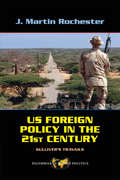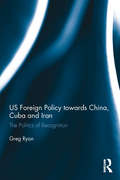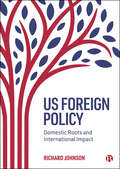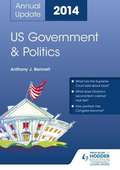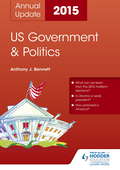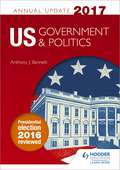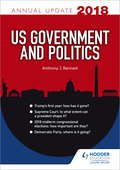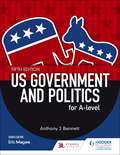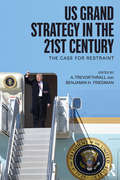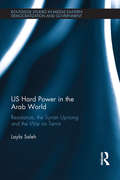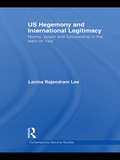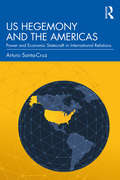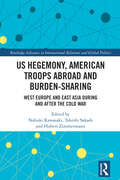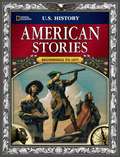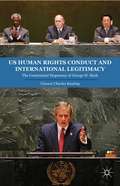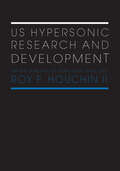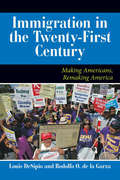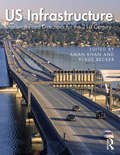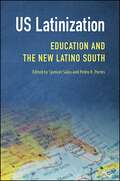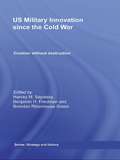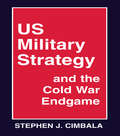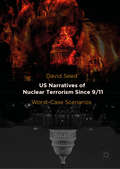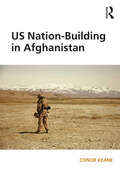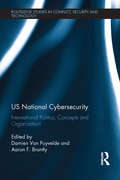- Table View
- List View
US Foreign Policy in the Twenty-First Century: Gulliver's Travails (Dilemmas In World Politics Ser.)
by J. Martin RochesterThe issues raised by the Iraq War are symptomatic of larger phenomena that will continue to preoccupy American foreign policy makers well into the twenty-first century. The war on terror, the proliferation of weapons of mass destruction, humanitarian intervention, and a litany of other concerns on the foreign policy agenda pose complex dilemmas for which there are no simple answers. Through lucid, lively analysis, as well as multiple illustrations and case studies, US Foreign Policy in the Twenty-First Century explores the difficult choices that confront the United States today in a complicated and often dangerous post-Cold War environment. Author J. Martin Rochester engages students in an intelligent examination of American foreign policy past, present, and future, involving them in critical thinking about how foreign policy is made, what factors affect foreign policy decisions and behavior, and how one might go about not only describing and explaining foreign policy but also evaluating it and prescribing solutions.
US Foreign Policy towards China, Cuba and Iran: The Politics of Recognition
by Greg RyanHistorically, the United States saw itself as embodying the best system of government with a foreign policy goal of bringing this system to the rest of the world. While Washington has, at times, dealt more realistically with other great powers at odds with this view, it has also attempted to alienate lesser states who reject the American system. The policies of non-recognition of China, Cuba and Iran were marked instances of this phenomenon. As the Obama administration renewed ties with Cuba and contemplated a more cooperative relationship with Iran, staunch opposition arose in defence of maintaining the long-standing policy of disengagement with these regimes. Providing a timely explanation for the origins of and continued support for US policies of non-recognition toward China, Cuba and Iran, this book demonstrates the links between IR theory and US foreign policy through the lens of the English School concept of International Society. It identifies historic costs stemming from US policies of non-recognition, and cautions that maintaining an overly narrow frame for understanding global politics will cause greater difficulties for US foreign policy in the future. This book will be useful for American researchers, graduate students and upper-level undergraduates in IR and American Foreign Policy. The inclusion of English School concepts and contrasting of IR theory inside and outside the US should also make it appealing to students in the UK and Australia.
US Foreign Policy: Domestic Roots and International Impact
by Richard JohnsonPaying close attention to its domestic roots, this textbook provides a valuable introduction to the construction and application of US foreign policy in the modern era. Accessibly written and including helpful illustrative material, a glossary and guide to further reading, it is organised around four broad themes: • the ideologies of US foreign policy; • the institutions of US foreign policy making; • the actors who influence and shape the content of US foreign policy; • the policy goals and ideas that motivate US foreign policy. Drawing from analyses of the broader history of US foreign policy throughout the post-Second World War period, the book encourages readers to think about how these ideas, institutions and goals have been at work in the foreign policy of recent presidential administrations, including those of George W. Bush, Barack Obama, Donald Trump and Joe Biden.
US Government & Politics Annual Update 2014
by Anthony BennettFeaturing information and analysis of recent events in US politics, this book provides you with topical source material to draw on for tasks throughout your course, and for answering examination questions. Written by an experienced and acknowledged expert in the field of US politics, this is the book you need if you are aiming for the highest grades at A2. - Reviews the key events and developments of 2013 you need to know - Students can analyse up-to-date examples and data to present knowledgable and persuasive arguments - Written by experienced authors who know what you need to know to get those top grades - The perfect update for your textbook, bringing you right up to date with all the topical material you need to succeed in your exams Contents: Chapter 1 What does Obama's second term cabinet look like? Chapter 2 'President Romney': another near-miss Electoral College oddity Chapter 3 Race, rights and the Supreme Court Chapter 4 The Supreme Court: the 2012-13 term Chapter 5 Just how partisan has Congress become and why? Chapter 6 New media vs old media: which is now more influential? Chapter 7 What makes President Obama's job so difficult? Chapter 8 The federal government shutdown, or a mad tea party? Chapter 9 Who's Who in US Politics
US Government & Politics Annual Update 2015
by Anthony J BennettFeaturing information and analysis of recent events in US politics, this book provides you with topical source material to draw on for tasks throughout your course, and for answering examination questions. Written by an experienced and acknowledged expert in the field of US politics, this is the book you need if you are aiming for the highest grades at A2.- Reviews the key events and developments of 2014 you need to know, including the midterm elections- Students can analyse up-to-date examples and data to present knowledgeable and persuasive arguments- Written by an expert in US politics who knows what you need to know to get those top grades- The perfect update for your textbook, bringing you right up to date with all the topical material you need to succeed in your examsContents 1. What can we learn from the 2014 midterm elections?2. So just how polarised is America?3. What's the Supreme Court been deciding in 2014? 4. By numbers: the Supreme Court's 2013-14 term5. How to fix the presidential nomination process6. Is Obama a weak president?7. Are congressional committees 'Congress at work'?8. What about the 2016 elections?Who's Who in US Politics 2015
US Government & Politics Annual Update 2016
by Anthony J BennettFeaturing information and analysis of recent events in US politics, the Annual Update provides you with topical source material to draw on for tasks throughout your course, and for answering examination questions. Written by an experienced and acknowledged expert in the field of US politics, this is the book you need if you are aiming for the highest grades at A2.- Reviews the key events and developments of 2015 you need to know- Students can analyse up-to-date examples and data to present knowledgeable and persuasive arguments- The perfect update for your textbook, bringing you right up to date with all the topical material you need to succeed in your examsTopics include:1. Which is healthier: the Democrats or the Republicans?2. How important is the Obama cabinet?3. What's happening in the 2016 presidential race?4. Presidential debates: are they substance or theatre?5. What's the Supreme Court been deciding in 2015?6. The Supreme Court: the 2014-15 term7. Women in US Politics: how much have things changed?8. Who's Who in US politics 2016
US Government & Politics Annual Update 2018
by Anthony J BennettTopical reading essential for exam success.- Review all the key developments in US politics from the last year, with expert analysis you can draw on both throughout your course and in the exams- Go beyond your textbooks to build a bank of up-to-date examples and data, helping you develop knowledgeable and persuasive arguments- Know how to hit the highest grades with guidance from experienced teacher and author, Anthony J. BennettContentsChapter 1: The Trump cabinetChapter 2: To what extent can a President reshape the Supreme Court?Chapter 3: The Supreme Court: the 2016/2017 termChapter 4: The Gorsuch nomination to the Supreme CourtChapter 5: More from the 2016 electionsChapter 6: The 2018 midterm congressional electionsChapter 7: Where's the Democratic Party going?Chapter 8: Presidential pardonsChapter 9: An assessment of Trump's first year
US Government and Politics for A-level Fifth Edition
by Anthony J BennettLet trusted author Anthony Bennett build your students political knowledge and understanding with our bestselling textbook, fully updated for the new specifications. Combining informed discussion with the latest facts and figures, this textbook provides accessible coverage of key topics for all exam boards.- Comprehensive coverage of the latest developments in US politics including the 2016 elections- Analysis and evaluation of the similarities and differences to UK politics- Definitions of key terms and concepts to help clarify knowledge and understanding of political language- Exam focus sections at the end of each chapter to test and develop understanding of key topics, offering practice for short and essay questions
US Grand Strategy in the 21st Century: The Case For Restraint (Routledge Global Security Studies)
by A. Trevor Thrall Benjamin H. FriedmanThis book challenges the dominant strategic culture and makes the case for restraint in US grand strategy in the 21st century. Grand strategy, meaning a state’s theory about how it can achieve national security for itself, is elusive. That is particularly true in the United States, where the division of federal power and the lack of direct security threats limit consensus about how to manage danger. This book seeks to spur more vigorous debate on US grand strategy. To do so, the first half of the volume assembles the most recent academic critiques of primacy, the dominant strategic perspective in the United States today. The contributors challenge the notion that US national security requires a massive military, huge defense spending, and frequent military intervention around the world. The second half of the volume makes the positive case for a more restrained foreign policy by excavating the historical roots of restraint in the United States and illustrating how restraint might work in practice in the Middle East and elsewhere. The volume concludes with assessments of the political viability of foreign policy restraint in the United States today. This book will be of much interest to students of US foreign policy, grand strategy, national security, and International Relations in general.
US Hard Power in the Arab World: Resistance, the Syrian Uprising and the War on Terror (Routledge Studies in Middle Eastern Democratization and Government)
by Layla SalehNeither stability nor change in the post-colonial Arab world can be fully understood without considering the international context, and American Foreign policy in particular. However, the exact nature of America’s presence in the Arab world, and the scope and modes of its influence, all appear to have reached a crossroads since the Arab uprisings. ‘US Hard Power in the Arab World’ traces the US’s "power of persuasion" in the Arab Middle East from the onset of the War on Terror in 2001 through to the Arab Spring. With a particular focus on Syria, the book explores the limits of an American "smart power" amid the emergence of a growing indigenous "soft power" whose ire is directed not only at Assad’s regime, but also at the violence perpetrated or enabled by the international community, headed by the US. It is argued that the blurring of the two forms of "soft" and "hard" American power has tarnished the credibility of US policies geared to win hearts and minds in the Arab world. ‘US Hard Power in the Arab World’ narrates the contests between attraction and intimidation, public diplomacy and military occupation, elites and publics, seduction and resistance. Drawing upon a multitude of primary sources, including personal interviews with Syrian activists and opposition figures, this book will be a valuable resource for students and scholars of Middle East Politics, as well as those concerned with American Foreign Policy and the Arab Spring.
US Hegemony and International Legitimacy: Norms, Power and Followership in the Wars on Iraq (Contemporary Security Studies)
by Lavina Rajendram LeeThis book examines US hegemony and international legitimacy in the post-Cold War era, focusing on its leadership in the two wars on Iraq. The preference for unilateral action in foreign policy under the Bush Administration, culminating in the use of force against Iraq in 2003, has unquestionably created a crisis in the legitimacy of US global leadership. Of central concern is the ability of the United States to act without regard for the values and interests of its allies or for international law on the use of force, raising the question: does international legitimacy truly matter in an international system dominated by a lone superpower? US Hegemony and International Legitimacy explores the relationship between international legitimacy and hegemonic power through an in depth examination of two case studies – the Gulf Crisis of 1990-91 and the Iraq Crisis of 2002-03 – and examines the extent to which normative beliefs about legitimate behaviour influenced the decisions of states to follow or reject US leadership. The findings of the book demonstrate that subordinate states play a crucial role in consenting to US leadership and endorsing it as legitimate and have a significant impact on the ability of a hegemonic state to maintain order with least cost. Understanding of the importance of legitimacy will be vital to any attempt to rehabilitate the global leadership credentials of the United States under the Obama Administration. This book will be of much interest to students of US foreign policy, IR theory and security studies. Lavina Rajendram Lee is a lecturer in the Department of Modern History, Politics and International Relations at Macquarie University, Australia, and has a PhD in International Relations from the University of Sydney.
US Hegemony and the Americas: Power and Economic Statecraft in International Relations
by Arturo Santa-CruzIn this book, Arturo Santa-Cruz advances an understanding of power as a social relationship and applies it consistently to the economic realm in United States relations with other countries of the Western Hemisphere. Following the academic and popular debate on the ebb and flow of US hegemony, this work centers the analysis in a critical case for the exercise of US power through its economic statecraft: the Americas—its historical zone of influence. The rationale for the regional focus is methodological: if it can be shown that Washington's sway has decreased in the area since the early 1970s, when the discussion about this matter started, it can be safely assumed that the same has occurred in other latitudes. The analysis focuses on three regions: North America, Central America and South America. Since each region contains countries that have at times maintained very different relationships with the United States, the findings contribute to a better understanding of the practice of US power in the sub-region in question, adding greater variability to the overall results. US Hegemony and the Americas: Power and Economic Statecraft in International Relations is an invaluable resource for students and scholars interested in Latin American History and Politics, North American Regional Integration, International Relations, Economic Statecraft, Political Economy and Comparative Politics.
US Hegemony, American Troops Abroad and Burden-Sharing: West Europe and East Asia during and after the Cold War (Routledge Advances in International Relations and Global Politics)
by Hubert Zimmermann Takeshi Sakade Nobuki KawasakiKawasaki, Sakade, Zimmerman, and their contributors examine the historical development of burden-sharing among the United States (US) and its allies after World War II, looking at examples from Western Europe and East Asia.Through a series of case studies, the contributors to this volume identify the characteristics and historical transformations in the burden-sharing relationships between the US and its allies. In addition to diplomatic and security concerns, they also look at the economic and financial dimensions of burden-sharing and how all these elements are intertwined. They also address the different dynamics of burden-sharing between the US and Western Europe – notably Germany and the United Kingdom (UK) – on the one hand and between the US and East Asia – particularly Japan and Korea – on the other. In particular, they argue that while Western European countries provided most of the economic and political support for American policies until the 1960s, the economic support from East Asian countries became much more important from the 1970s onwards.This book is a valuable contribution to the literature on burden-sharing and strategic alliance for scholars of international relations and the diplomatic history of the Cold War.
US History: American Stories, Beginnings to 1877
by National Geographic StaffThe history of the United States is a chronicle of different regions that today are pulled together on a cultural basis. In the early years, our identity as a nation was defined on a military or political basis-- and we're still struggling with those differences.
US Human Rights Conduct and International Legitimacy
by Vincent Charles KeatingWas the Bush administration was successful in legitimating its preferences with habeas corpus, torture, and extraordinary rendition? As American transforms in the post-Bush era, scholars have begun to assess the post-9/11 period in American foreign and domestic policy, asking difficult questions regarding torture and human rights.
US Hypersonic Research and Development: The Rise and Fall of 'Dyna-Soar', 1944-1963 (Space Power and Politics)
by Roy F. Houchin IIAn essential new account of some of the most valuable research and development in international military history. Roy F. Houchin II shows how the roots of US Air Force hypersonic research and development are grounded in Army Air Force General Henry H. 'Hap' Arnold's identification of the need for advanced airpower weapon systems to meet the anticipated postwar enemy threat. The technology for a smooth transition to military spaceflight seemed within reach when Bell Aircraft Corporation executive Walter Dornberger (the former commander of Nazi Germany's V-2 rocket research) made an unsolicited proposal to William E. Lamar (the chief of Wright Aeronautical Development Center's New Development Office of the Bomber Aircraft Division at Wright-Patterson AFB, OH) for a hypersonic boost-glide weapon system. Visionaries like Arnold, Dornberger, and Lamar believed a hypersonic boost-glider would represent the ultimate expression of the US Air Force's doctrine by performing strategic bombardment and reconnaissance more successfully any other type of vehicle. As this aspiration reached maturity in Dyna-Soar, the service's leadership never gave up their beliefs. This book shows how the struggle to persuade the secretary of defence and his advisors, who did not share the Air Force's vision for a military spaceplane, illustrates the ebb and flow of an advanced technology program and its powerful legacy within American society.
US Immigration in the Twenty-First Century
by Louis Desipio Rodolfo O. de la GarzaImmigration in the Twenty-First Century is a comprehensive examination of the enduring issues surrounding immigration and immigrants in the United States, beginning with a look at the history of immigration policy, followed by an examination of the legislative and legal debates waged over immigration and settlement policies today and concluding with a consideration of the continuing challenges of achieving immigration reform in the United States. The authors also discuss the issues facing immigrants in the United States, from the reception of immigrants within the native population to the relationship between minorities and immigrants. Immigration and immigration policy continues to be a hot topic on the campaign trail, and in all branches of federal and state government. U. S. Immigrants and Immigration Policies in the Twenty-First Century provides students with the tools and context they need to understand these complex issues.
US Imperialism: The Changing Dynamics of Global Power (Studies In Critical Social Sciences / Critical Global Studies #83/6)
by James PetrasThis book offers a broad and deep examination of the dynamics of US imperialism. Petras analyzes imperialism not only as economic domination, showing that its impact in the world takes many forms, including cultural, political and historical. He points to the disruptive effects it has on other world regional economies and cultures. Capitalism and imperialism take diverse forms but both are intimately tied to the projection of state power in the service of capital—a strategy designed to advance the geopolitical and economic interests of the US economic elite and ruling class—interests that are equated with the 'US national interest'.
US Infrastructure: Challenges and Directions for the 21st Century
by Aman Khan Klaus G. BeckerThis book presents an in-depth look at US infrastructure and its challenges in the 21st century. While infrastructure has received considerable attention in recent years, much of the discussion has concentrated on physical, economic, or noneconomic conditions. The Trump administration has heightened interest in the topic, promising infrastructure spending during his tenure, yet little demonstrable progress has been made. This book brings together a multi-disciplinary perspective—structural, technological, economic, financial, political, planning, and policy—that has been largely absent in discussions on the subject, to provide a clearer and broader understanding of the challenges facing US infrastructure. The book is divided into three parts: Part I looks at the challenges from a structural, technological, and sustainability perspective; Part II from an economic, productivity, and finance perspective; and Part III from an institutional, security, and political perspective. Written primarily for policy makers, managers, and administrators in public and private organizations, as well as individuals and academics with an interest in the future of US infrastructure, this book provides an in-depth analysis of the US infrastructure problem, its causes and consequences, and suggests timely, specific measures that may be taken at the state, local, and federal levels to improve and better secure our roads, transit, public buildings, economy, and technology.
US Latinization: Education and the New Latino South
by Spencer Salas; Pedro R. PortesOffering a much-needed dialogue about Latino demographic change in the United States and its intersections with P–20 education, US Latinization provides discussions that help move beyond the outdated idea that Mexican and Spanish (language) are synonyms. This nativist logic has caused "Mexican rooms" to re-emerge in the form of English to Speakers of Other Languages (ESOL) transitional programs, tagging Latinos as "Limited English Proficient" in ways that contribute to persisting educational gaps. Spencer Salas and Petro R. Portes bring together voices that address the social and geographical nature of achievement and that serve as a theoretical or methodological resource for educational leaders and policy makers committed to access, equity, and educational excellence.
US Military Innovation since the Cold War: Creation Without Destruction (Strategy and History)
by Harvey Sapolsky Benjamin Friedman Brendan GreenThis book explains how the US military reacted to the 'Revolution in Military Affairs' (RMA), and failed to innovate its organization or doctrine to match the technological breakthroughs it brought about. Many called for the transformation of the US military in the years after the end of the Cold War, seeking the changes in organization and doctrine that would complete the RMA innovation and a commitment to counter-insurgency, peace keeping and nation building missions. This volume describes the origins, uses, and limits of the RMA technologies, examines how each of the five US armed services (categorising the Special Operations as a separate service) made their adjustments both to the technologies and the use of force, and how the role of the civilian officials and the defense industry altered in this process of change and avoidance of change. The book examines the internal politics of the services as well as civil/military relations to identify the external pressures on the services for significant change in their doctrine and weapons. Many have noted the failure of the services to innovate in what can be called the 'Second Inter-war Period' (the years after the Cold War). This book offers explanations for this failure and arguments about the possible range and desirability of military innovation in the post-Cold war era. This book will be of great interest to students of strategic studies, US defence politics, military studies, and US politics. Harvey M. Sapolsky is Professor of Public Policy and Organization in the Department of Political Science at MIT and former Director of the Security Studies Program. Benjamin H. Friedman is a Research Fellow in Defense and Homeland Security Studies at the Cato Institute and a Ph.D. Candidate in Political Science at MIT. Brendan Green is a Ph.D. Candidate in Political Science at MIT and an affiliate of the Security Studies Program.
US Military Strategy and the Cold War Endgame
by Stephen J. CimbalaAt the end of the Cold War security concerns are more about regional and civil conflicts than nuclear or Eurasian global wars. Stephen Cimbala argues that deterrence characteristics of the pre-Cold War period will in the 21st century again become normative.
US Narratives of Nuclear Terrorism Since 9/11: Worst-Case Scenarios
by David SeedThis study examines the US fiction and related films which makes a series of interventions in the cultural debate over the threat of nuclear terrorism. It traces the beginnings of this anxiety from the 1970s, which increased during the 1990s after the collapse of the Soviet Union. The traumatic events of 9/11 became a major reference point for this fiction, which expressed the fear that of a second and worse 9/11. The study examines narratives of conspiracies which are detected and forestalled, and of others which lead to the worst of all outcomes – nuclear detonations, sometimes delivered by suitcase nukes. In some of these narratives the very fate of the nation hangs in the balance in the face of nuclear apocalypse. The discussion considers cases of attacks by electromagnetic pulse (EMP), cyberterrorism and even bioterrorism. Some of the authors examined are present or former politicians, members of the CIA, and former president, Bill Clinton.
US Nation-Building in Afghanistan (Open Access)
by Conor KeaneWhy has the US so dramatically failed in Afghanistan since 2001? Dominant explanations have ignored the bureaucratic divisions and personality conflicts inside the US state. This book rectifies this weakness in commentary on Afghanistan by exploring the significant role of these divisions in the US’s difficulties in the country that meant the battle was virtually lost before it even began. The main objective of the book is to deepen readers understanding of the impact of bureaucratic politics on nation-building in Afghanistan, focusing primarily on the Bush Administration. It rejects the ’rational actor’ model, according to which the US functions as a coherent, monolithic agent. Instead, internal divisions within the foreign policy bureaucracy are explored, to build up a picture of the internal tensions and contradictions that bedevilled US nation-building efforts. The book also contributes to the vexed issue of whether or not the US should engage in nation-building at all, and if so under what conditions.
US National Cybersecurity: International Politics, Concepts and Organization (Routledge Studies in Conflict, Security and Technology)
by Damien Van Puyvelde Aaron BrantlyThis volume explores the contemporary challenges to US national cybersecurity. Taking stock of the field, it features contributions by leading experts working at the intersection between academia and government and offers a unique overview of some of the latest debates about national cybersecurity. These contributions showcase the diversity of approaches and issues shaping contemporary understandings of cybersecurity in the West, such as deterrence and governance, cyber intelligence and big data, international cooperation, and public–private collaboration. The volume’s main contribution lies in its effort to settle the field around three main themes exploring the international politics, concepts, and organization of contemporary cybersecurity from a US perspective. Related to these themes, this volume pinpoints three pressing challenges US decision makers and their allies currently face as they attempt to govern cyberspace: maintaining international order, solving conceptual puzzles to harness the modern information environment, and coordinating the efforts of diverse partners. The volume will be of much interest to students of cybersecurity, defense studies, strategic studies, security studies, and IR in general.
